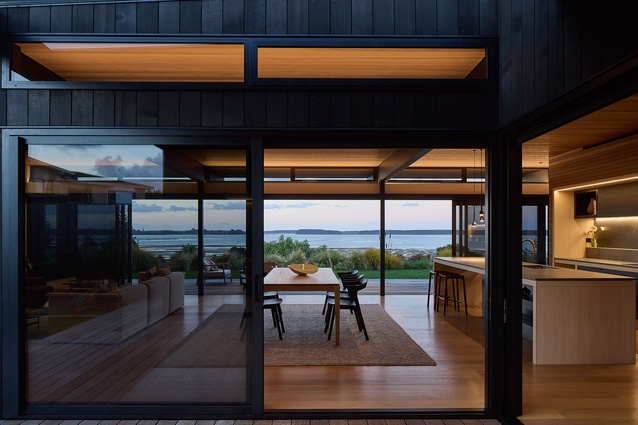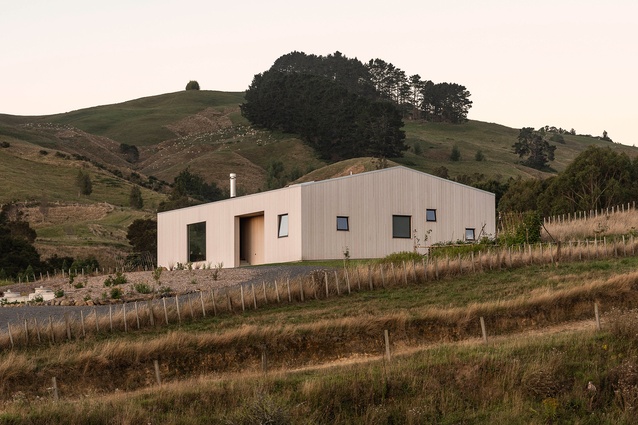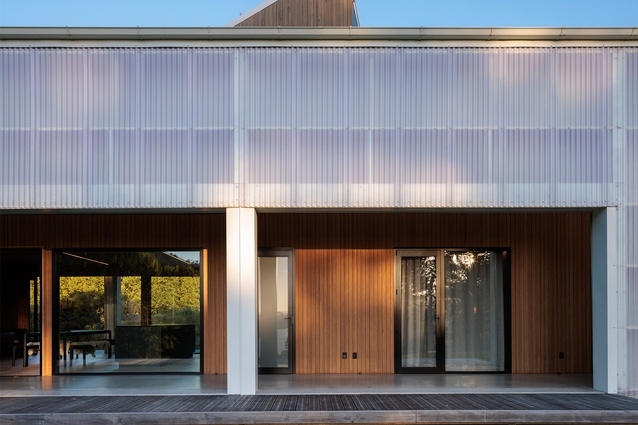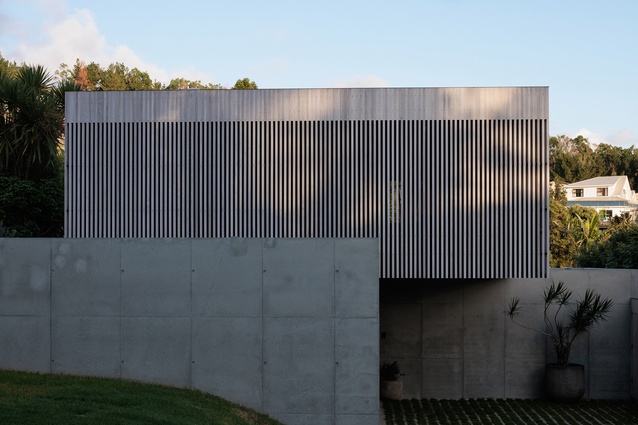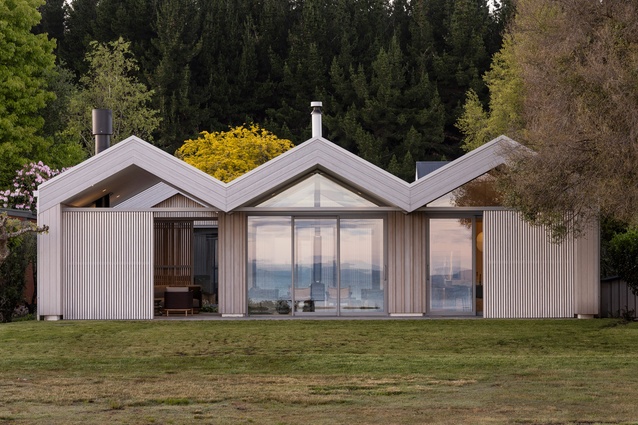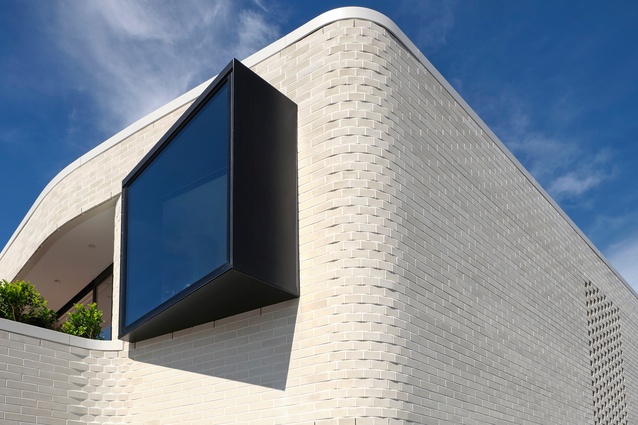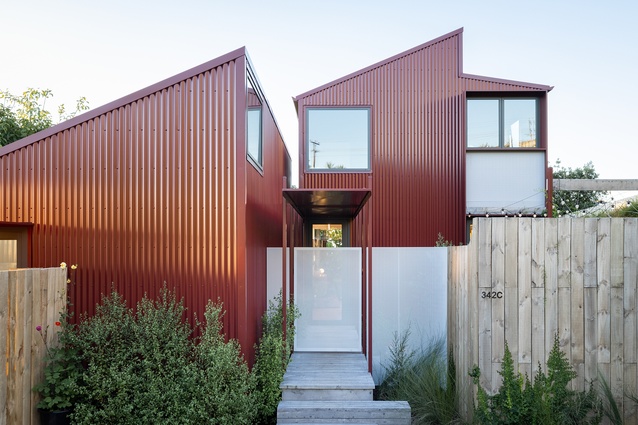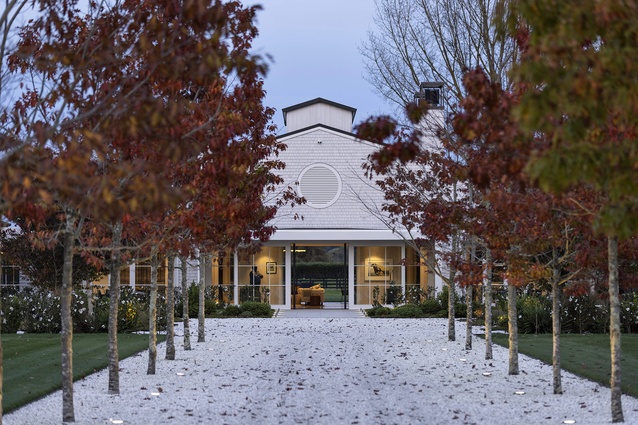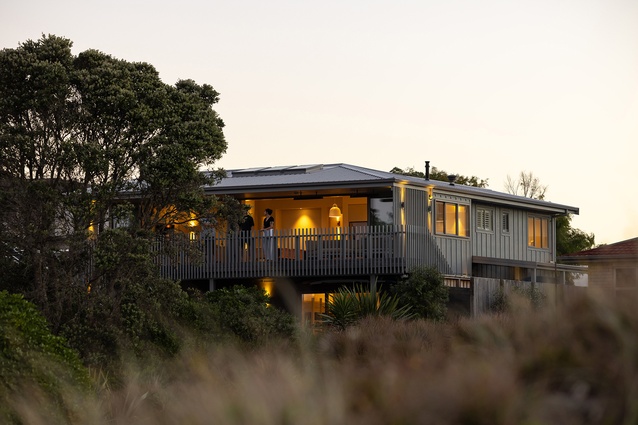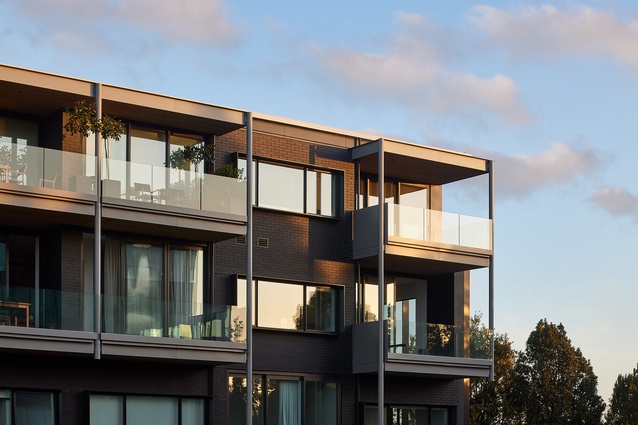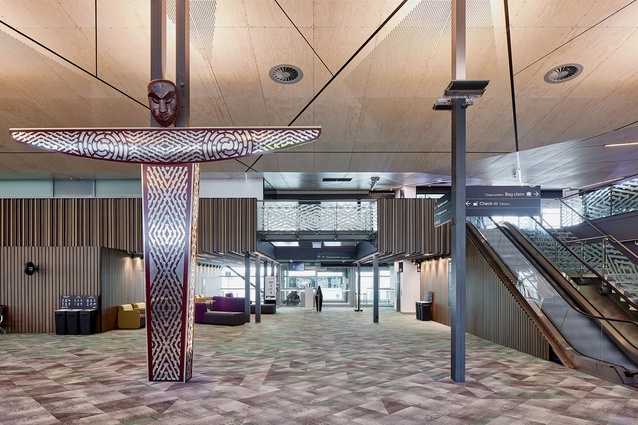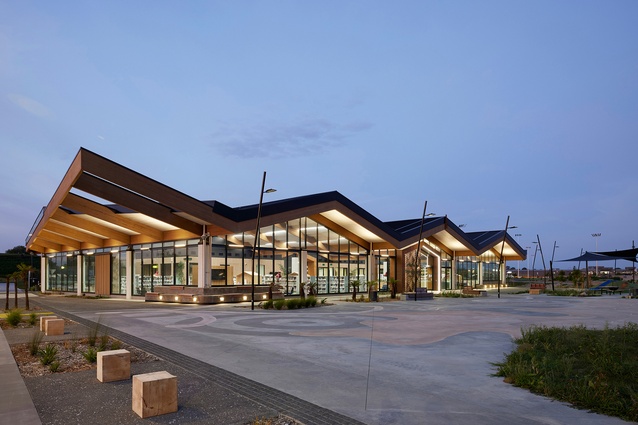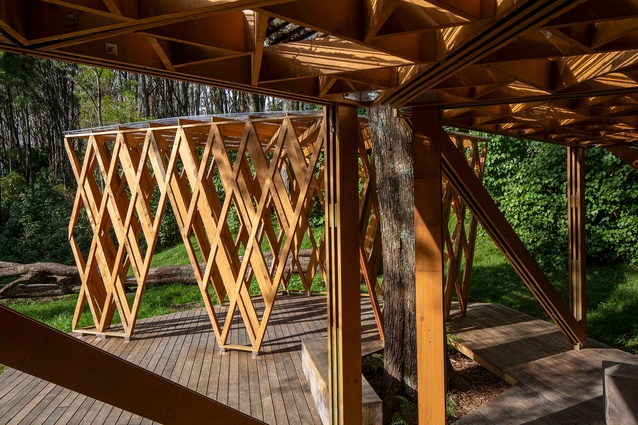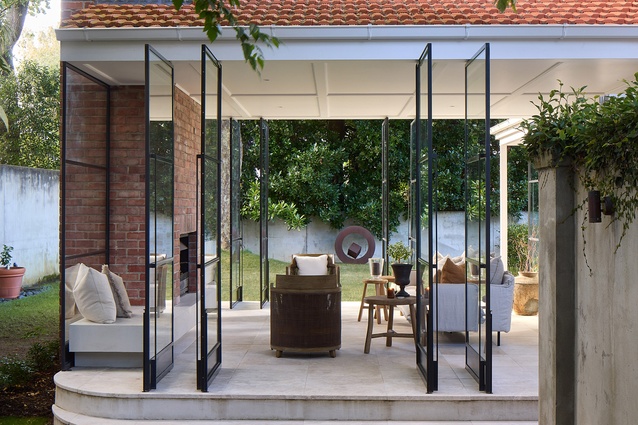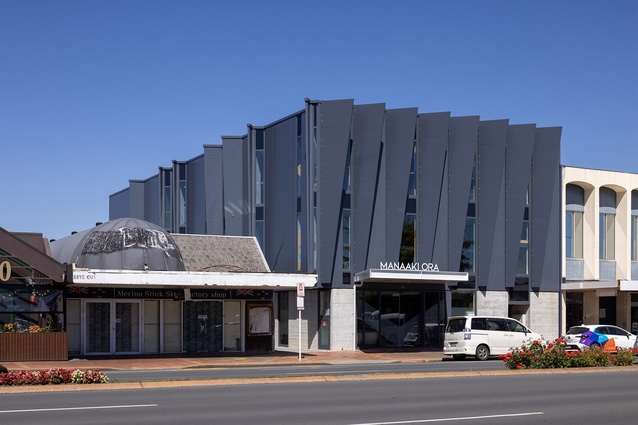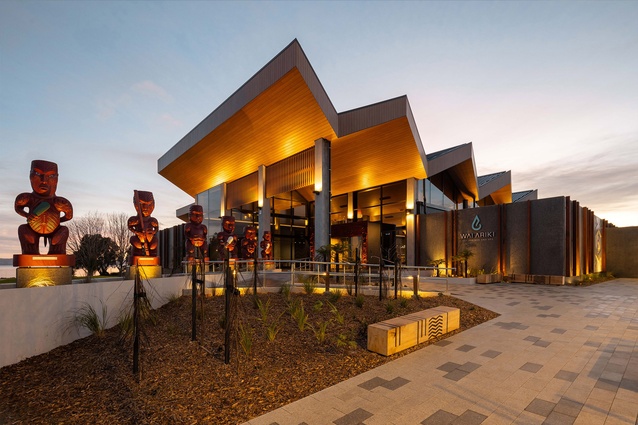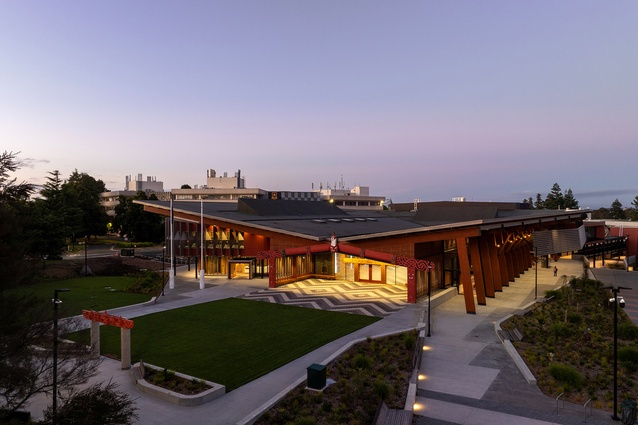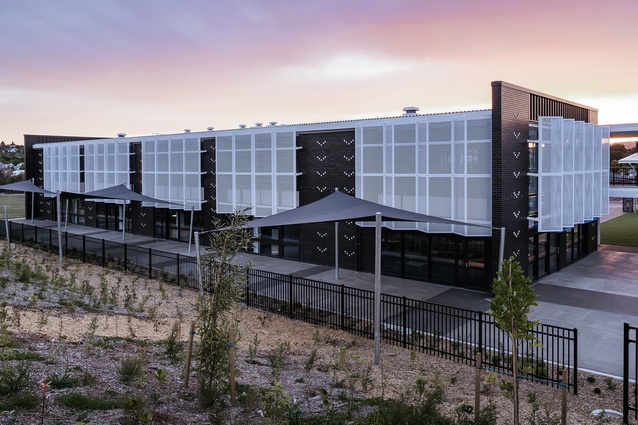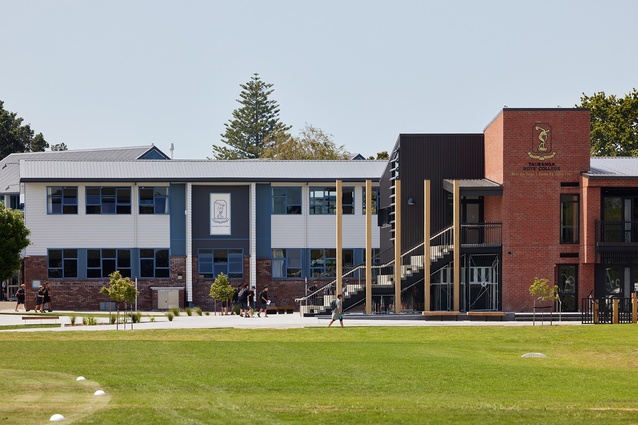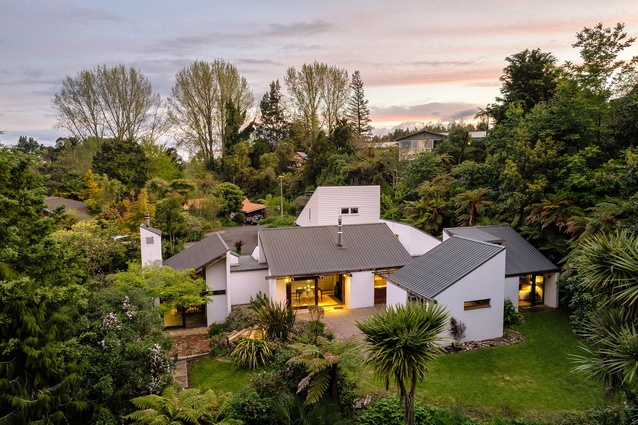Winners: Waikato and Bay of Plenty Architecture Awards 2024
From highly conceptual projects that redefine architecture to traditional high-end homes, the winners of this year’s best architecture in the Waikato, and Bay of Plenty, run the gamut of design.
The winning projects receiving a Te Kāhui Whaihanga New Zealand Institute of Architects Local Award from this region of were announced at an event at The Cargo Shed, Tauranga, on 2 May.
The 29 winners include a groundbreaking building inspired by the journey of Te Arawa that houses counselling services, an illuminated fibreglass holiday home, and a tiny home for hobbits.
Jury convenor, architect Matt Grant says that the judges were impressed by the presence of te ao Māori in projects in many categories. Hamilton Kirikiriroa Airport, Te Rito O Manaaki Ora, Wai Ariki and Te Kura o Manunui are amongst the winning projects that have been imbued with a deep sense of Māori culture and design.
“From simple fit-outs to major commercial work, it’s clear that in our region, iwi consultation is taken very seriously and Māori-influenced architecture is thriving,” says Grant. “These forms are incredibly innovative and the potential for them to inform resilient, affordable construction is massive.”
The use of colour to transform the experience of being in a building is another theme found in a handful of this year’s winners. Six projects will receive Resene Colour Awards, including House on A Hill, a red corrugated iron home that features soothing interior colours to intentionally imbue a sense of calm, and The Pā, a student hub and Faculty of Māori and Indigenous Studies at the University of Waikato, where colour is used to foster a warm welcome for visitors.
“Colour is being taken seriously by architects as a method of affecting an environment; from rich, bright and vibrant colours, to cool, relaxing and calming hues,” says Grant.
Unconventional projects make an appearance too. Summerhill Pavilions ’21 and ’22, a winner in the Small Project Architecture category, pushes the definition of architecture to its limit, with wall-less, latticework timber shelters inspired by ancient Japanese and Māori craftsmanship.
The Chodge, a holiday home that is shaped like a woolshed and is constructed from illuminated fibreglass so as to be seen from afar, reinvents the idea of a rural dwelling. And the Hobbit homes nestled by Tilt Architecture into a hillside at Hobbiton, are similarly unconventional, and awarded in the Commercial Architecture category for their ability to transport visitors to Middle Earth.
Convenor architect Matt Grant was joined on the jury by Malcolm Taylor of Malcolm Taylor and Associates, Carl de Leeuw of WSP Architecture, Colette McCartney of GHD Design, and lay juror Anna Wilkinson from Area Design, Hamilton.
The winning projects are:
Housing
Whareroa by Bossley Architects

Tucked into the hillside and hiding in plain sight, the living roof seamlessly integrates the house into the environment and provides an attractive elevation from the bush-walking track behind the site. The light stalks create an intriguing display of colour at night and funnel light deep down into the plan. The building opens up to the north-west, welcoming the native forest indoors, while also cocooning bedrooms into the hillside. The house is both strong and gentle, protective and open, and emanates serenity — a wonderful place to relax and enjoy a slower pace of life.
Matua Masterclass by Brendon Gordon Architects
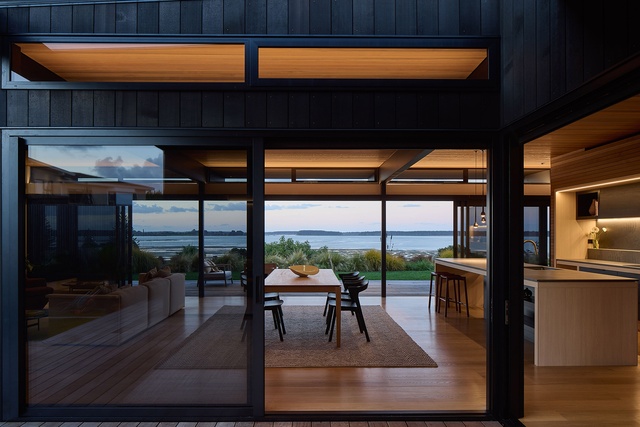
Judiciously placed within its suburban cul-de-sac setting, this new dwelling provides a successful series of living spaces for its residents. The collection of black cedar-clad boxes at the street give nothing away. On entry, the eye is immediately directed to the harbour vista. The choreographed courtyard cleverly slows the procession to the main living space, opening into a generous light-filled west courtyard and living space that stretches across the site. The long roof form mimics the expansive Tauranga harbour, partly a result of the restricted building height plane. While the choice of a sarked timber ceiling lowers the expanse of the living space, it also delivers a more intimate experience. The attention paid to the cabinetry and lighting references mid-century modern homes of west-coast America. The architect is in complete control of his craft.
French Pass House by Christopher Beer Architect
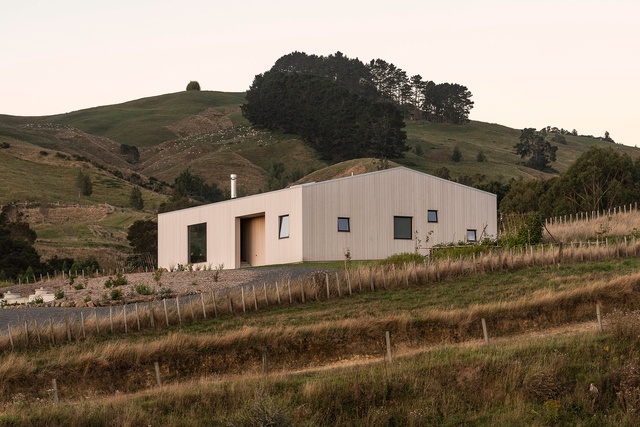
Approaching the French Pass House is like encountering a couple of chiseled remnant glacial blocks. The home and separate garage rise from the ground as though they’ve rested there for some time and become embedded. Oriented and designed to capture near and far views, a clear space-path-ritual is set up as you arrive, enter and move through the home. The simple form belies spatial depth, which accommodates separate rooms and spaces where each occupant has found their own favourite spot. Playful shuttered windows allow a shaft of light to mark the passing of time, a glimpse into the distance or an alternative entrance for the dog. Low-silled sliding windows provide a direct escape into the field for the child (or child at heart). The generous covered terrace mortised into the northern corner extends living outdoors and can be used throughout the year. Careful detailing maintains effortlessly clean lines.
The Chodge by DCA Architects of Transformation
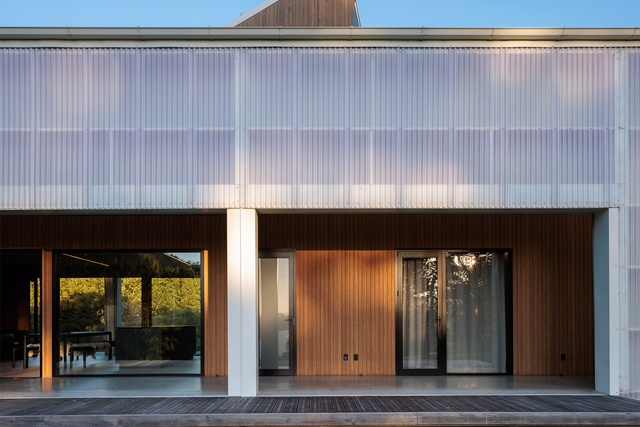
The dwelling is a beacon of white reinforced polycarbonate fiberglass on an elevated site visible from the State Highway. An interpretation of Nigel Cook’s work from the 1980s and early 90s, it is reminiscent of a woolshed, opening up to the landscape through translucent fire-station doors and a verandah. Within the outer shell is an extruded timber living container designed to Passive Haus principles, cave-like and in stark contrast to the external structure. Essentially a house within a house. The interior joinery, furnishing and palette are well considered and contemporary, with the warmth of waxed-oak veneer creating a relaxed, sophisticated aesthetic. The result is an architectural delight, a triumph of technology, simplicity and pushing the envelope on planning and building rules.
Coromandel House by Evelyn McNamara Architecture
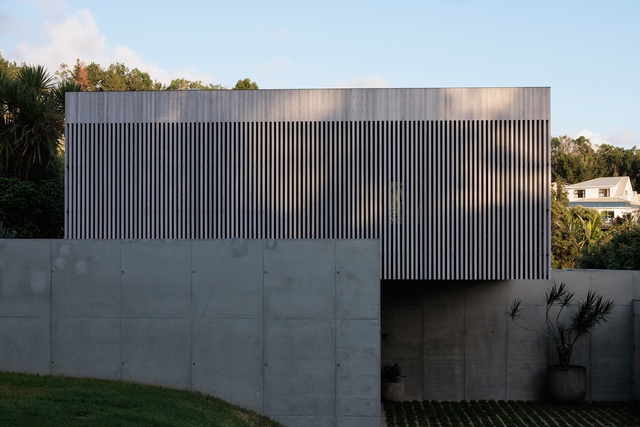
Originally conceived as a holiday home for its owner, this project evolved into a family’s permanent residence in the sleepy Coromandel township of Onemana. The design pushes the boundaries of site coverage and materiality, a modern concrete home inspired by the mood and aesthetic of Tadao Ando. Inside, the home feels modern and sophisticated, warm and inviting. Interior timber lining creates a welcoming, calming feeling. The courtyard and outdoor space create a tranquil oasis and sense of privacy, despite the proximity of neighbours. Light shafts, level changes and shadow plays create interest and privacy while maintaining views to the rolling hills and streetscape.
Lake Taupo House by RTA Studio
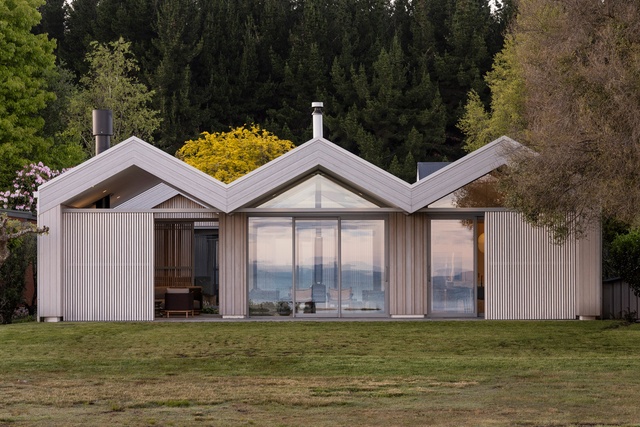
The conceptual catalyst for this replacement home was a cluster of boatsheds. Now, a trio of connected gables thoughtfully return the occupation of this site to a reduced scale that’s sympathetic to the setting. The volumes deftly slide past each other to break up the mass on arrival, while connecting and creating spaces within. The central courtyard enables the surrounding spaces to extend into sheltered outdoor areas during inclement weather. Sliding screens tune the level of privacy, allow adjustments to suite weather conditions and create intimate semi-outdoor areas with a variety of views.
Grace by Stevens Lawson Architects

In suburban Mount Maunganui, constrained on all sides, this built form appears effortless rather than driven by tight planning restrictions. Cleverly placed windows, breezeway brick screens and an inverted living programme provide privacy in an otherwise dense setting. The ephemeral and climactic are expressed within this home through the lozenge-shaped roof light, hovering over the upper living zone. Soft light delivers a negative shape of the maunga, which is in direct line of sight on arrival. This house provides varying levels of enclosure, exposure to the natural elements and — importantly — a strong connection to its beachside location.
House on a Hill by Stufkens + Chambers Architects

Careful material selection playfully engages the senses and invites tactile exploration in a home that actively engages its occupants. From textural corrugated iron cladding to fragrant Lawson cypress, every surface has been carefully considered for form and function. The house responds skillfully to the site’s constraints and restrictions, nestling into a bank on one side and seemingly floating within established trees on the other. Surrounded by greenery, it’s a family sanctuary.
Resene Colour Award
A playful and judicious use of colour alongside clever material choices such as raw timber and red Colorsteel create a welcoming and visually stimulating home.
Stud Farm Residence by Sumich Chaplin Architects
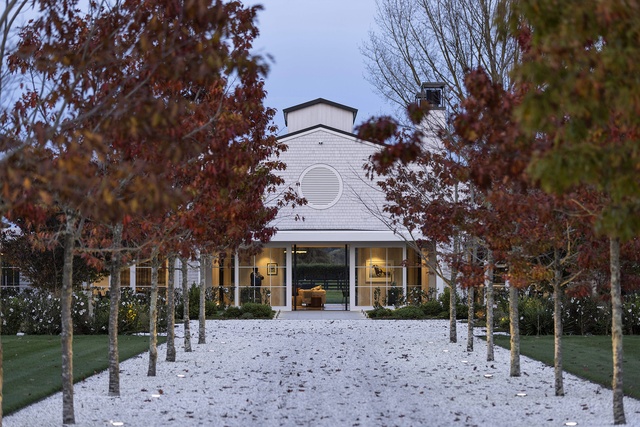
This home adopts an aesthetic inspired by stables on the thoroughbred horse farm. Located on a mostly flat site with expansive views across the farm and beyond, the design revolves around a solid axis. Barn forms are linked by glazed gallery spaces to retain visual connection to the landscape. The interior design features a carefully considered material palette of timber, stone, tile and rendered plaster, creating a timeless sense of warmth and permanency.
Housing – Alterations and Additions
He Iti Ake by Architecture Bureau

With a clear and incisive strategy, the architect has cleverly unlocked opportunities to transform an old holiday home into a cohesive, well-planned modern residence. Improved circulation, skylights and extended living spaces combine to create a comfortable and uplifting environment. Through discernible reduction in the built form, deft planning and unlocking the site’s existing qualities, the architect has vastly improved the quality of the building.
Housing – Multi Unit
Hills Residences by Edwards White Architects

Working with the existing building structure was a difficult proposition but the architect and client have achieved a landmark result for Hamilton East. Transitioning from a laboratory to residential apartments with capacity for future commercial spaces, this project exemplifies a thoughtful approach to adaptive reuse. The existing structure has been expressed internally, with concrete columns stripped back to reveal the history and original patina. The new apartments are warm, inviting and reflect a high-quality residential aesthetic with timber cabinetry and stone benchtops. A quality reuse of a building that has revitalised a corner of Hamilton East.
Interior Architecture
Hamilton Kirikiriroa Airport by AWA Architects

What started as a furniture refresh evolved into a multi-year refurbishment and seismic strengthening project that would challenge the design team to deliver a coherent and welcoming place. At the crossing point of transit between earth and sky, arrival and departure, there is now a clear cultural identity that speaks to site and context. The design stripped back clutter and a motley collection of materials and objects that had gathered like lost luggage over time. The result is clear wayfinding, connection between spaces, improved functionality, flow and performance in a welcoming environment. The cultural narrative established at the outset enabled a clear story to be manifested in design and detailing. It speaks of the site’s former position as a crossing point of pathways and trading routes and was used as a touchstone by the wider design team, other disciplines and artists. The hero is the patterned ceiling, a protective cloak symbolising intersecting paths and life’s cyclical patterns, which unifies disparate existing roofs.
Resene Colour Award
A careful and considered use of colour and colour selections calm the experience of the space, support the narrative behind the design, and aid movement and congregation.
Baker Tilly Staples Rodway Fitout by Chow:Hill Architects

Baker Tilly Staples Rodway occupy the third floor of the six-storey Building E development in Hamilton. An established and successful partnership between client and architect has raised the bar of interior design. The purposeful but still subtle and methodical arrangement of workspaces fosters connectivity among staff who were previously siloed. Natural light is used to full effect, creating a bright, inviting and uplifting space. Cool, industrial vertical and horizontal planes are juxtaposed with soft furnishings and lush pockets of natural plants to create an ambience that is delightful in every sense.
Resene Colour Award
By selecting a high level of materials and finishes, the architect has created a lush interior that shifts comfortably between different tones, textures, shapes and scale. The building’s internal core edges are softened through the generous use of curves and articulated with walls lined in vertical white brick. Services and ceiling structure are expressed, and the internal material selection is complementary and cohesive. Colour surprises and delights everywhere.
Public Architecture
Puna Kaukau o Te Oko Horoi – Perry Aquatic Centre by Architecture HDT
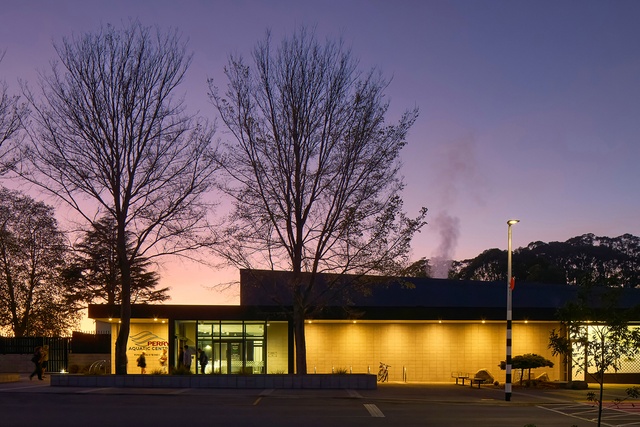
A significant project for Cambridge, and more than 15 years in the making, this aquatic complex seamlessly integrates with the existing 50-metre pool and grounds, enveloping the southern edge of the site and offering connectivity through expansive windows in the main pool hall. The angular form, characterised by clean lines and three distinct volumes, mitigates visual bulk at the street, and blends harmoniously with the surrounding residential context. Internally, the pool hall is bathed in natural light from west and east-facing floor-to-ceiling glazing with pops of colour, reflective of Waipa, to enhance the user experience.
Te Kete Aronui Rototuna Library by Chow:Hill Architects
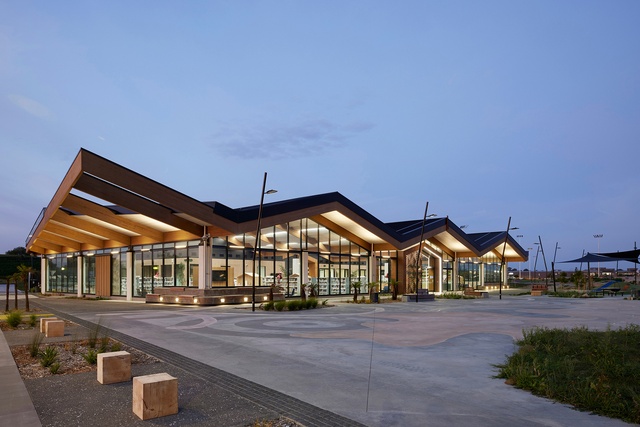
As a keystone facility to build this new community, Te Kete Aronui Rototuna Library provides many functions beyond traditional library services, bringing together council services, community rooms, and a café with study, maker- and play-spaces both inside and outside.
As a community focal point, the library responds well to the ‘theatre in the round’ challenge of being accessible and visually connected on all sides. It does this by extending the plan and zoning designs beyond the external walls to the surrounding landscaped areas and creating opportunities for connection inside and outside. The plan increases utility and enables larger meeting rooms and facilities to be available to the library or isolated for independent use by community groups out of hours.
Hamilton Gardens, Ancient Egyptian Garden by Peddlethorp

The Ancient Egyptian Garden complex is one of more than 20 themed gardens at this public destination. This garden represents one of the earliest decorative traditions and is a faithful reproduction of a 2000 BC Egyptian domestic productive setting. Shapes, material finishes, murals and hieroglyphics have all been reproduced based on historical evidence and created in consultation with an Egyptologist. There is a consistently high level of design, finish and historical accuracy on show — an asset that will delight visitors.
Resene Colour Award
Essentially this is research-led design, which has created a spectacular project. The vibrant murals and hieroglyphics on display were reproduced from a colour palette provided through Egyptological research. On almost every surface, colour is used with purpose and vigour. The architect has created a magnificent experience that is as much about colour as it is architecture.
Small Project Architecture
Summerhill Pavilions ’21 & ’22 by Andrew Barrie Lab
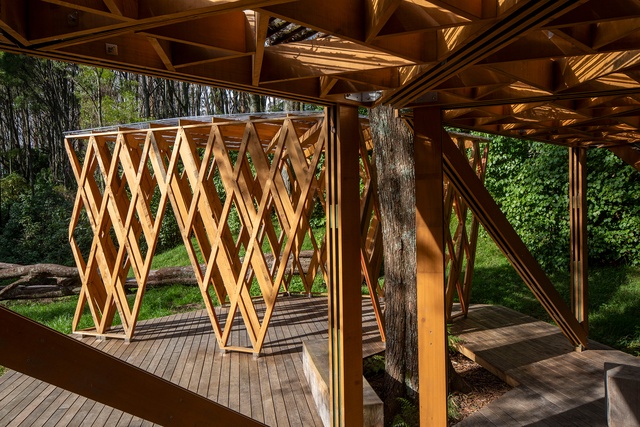
These two structures combine ancient timber techniques with contemporary digital milling technology and pragmatic agricultural materials and fittings. The project’s goal was for lightweight, sustainable structures that expand the possibilities for timber construction, a response to the current climate emergency. The pavilions use of ancient Japanese wedged joint techniques and unique Māori building technologies are commendable. Especially valuable is a demonstration of post-tensioned heavy timber construction of pre-colonial Māori whare.
Whare Mīmīrū by Dr Anthony Hoete and Dr Jeremy Treadwell in association

Whare Mīmīrū adds to the commentary on pre-colonial structures of Aotearoa. An example of research-led design, this temporary post-tensioned structure represents community-led architecture beyond the library and laboratory of a conventional university. This is research activated on marae, utilising hapū as a builder. The knowledge was co-created and dissipated through kōrero, empowering hapū as mātauranga researchers. Whare Mīmīrū offers possibilities to how we might build resilient post-tensioned timber housing in the future.
The Garden Room by Edwards White Architects
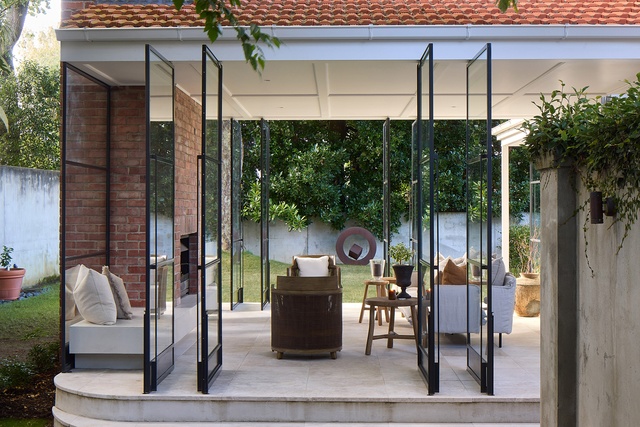
This beautiful addition to the original 1920s home honours heritage while providing a contemporary outdoor living space that connects with the surrounding landscape. The thin-profile pivot-steel joinery adds an elegant windbreak, reminiscent of traditional glasshouses and conservatories. The introduction of the skylight to draw light deep into the kitchen and dining room is a well-considered decision that creates a distinct separation between old and new, visually integrating the indoor and outdoor spaces and enhancing functionality.
Commercial Architecture
Te Rito O Manaaki Ora by DCA Architects of Transformation
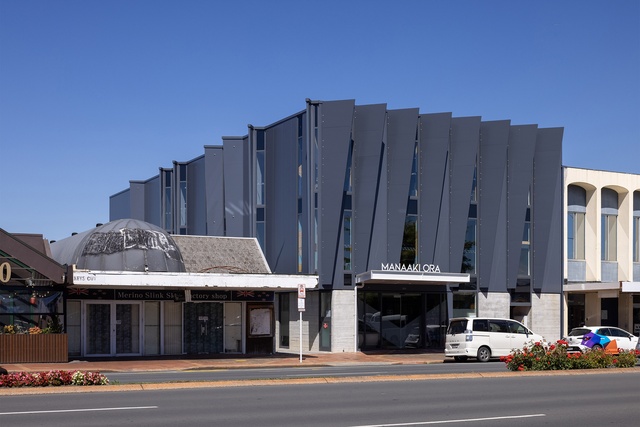
Te Rito o Manaaki Ora building celebrates cultural identity and wellbeing, providing a warm, inclusive and non-clinical facility for its clients and team. The undulating façade captures the journey of Te Arawa to Aotearoa and the importance of the Pacific Ocean, while also helping to control solar gain on the western façade. Hahau Matangi, the impressive poupou, traverses the building’s three floors. This building is a celebration of the safety of tangata, kōrero and mahi. The tones of the colour palette are warm and many walls have tactile surfaces. Everywhere, a high level of finish and materiality is demonstrated.
Resene Colour Award
A carefully considered palette and unique pattern language is beautifully integrated into each interior space, creating a rich cultural narrative and identity for all three levels of the building.
Bricks and Mortar by Edwards White Architects
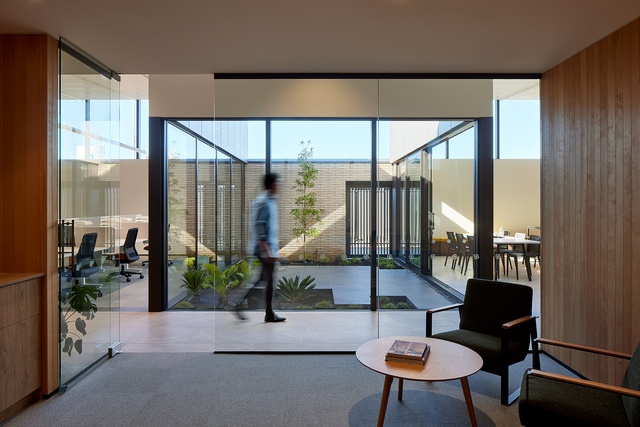
This gently scaled building asserts itself among its tough neighbours on a site previously occupied by a mechanic’s workshop. The scale of the street elevation, its richly tactile surface and the human activity of the boardroom offer vitality to a streetscape otherwise devoid of such gestures. High-level south-facing windows provide abundant natural light to the interior, which includes an internal courtyard garden. This is a carefully considered building with a high level of attention to detail. Its ability to re-energise a busy street and still offer a meticulously crafted and generous oasis is commendable.
MADE by Edwards White Architects
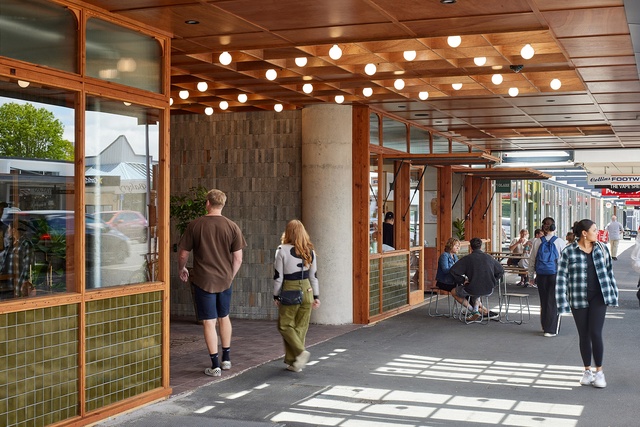
This wonderful new development in Hamilton East repurposes an old council building into a vibrant village hub. A curated selection of artisan vendors culminates in an exciting shopping experience and brings together some of Waikato’s most creative makers and doers. The spiral staircase builds a connection from the street to the river, while the open balconies provide sweeping views across Hamilton’s CBD to Pirongia. This development is a celebration of the city and its creative talent.
Wai Ariki by RCG and Pukeroa Oruawhata Lakefront Holdings in association
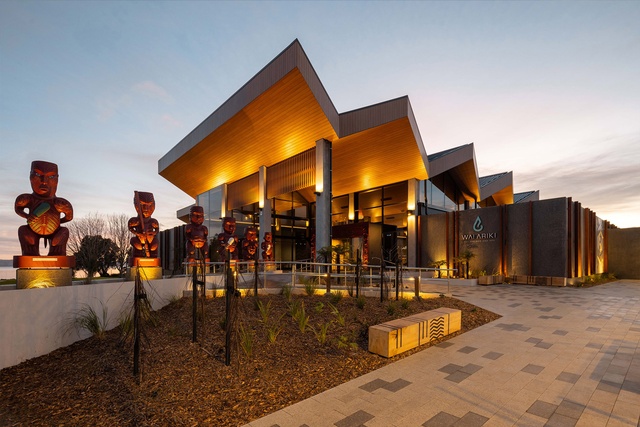
The brief for the site on the marshy and highly active geothermal shores of Lake Rotorua was to create a luxury spa like no other — architecturally, experientially and culturally. The result — Wai Ariki, meaning chiefly waters — fosters deep connection with the land and its people, and is the most significant spa to be developed in Aotearoa in more than 100 years. The floorplan is arranged around the key journeys of bathing and healing, which are based on Ngāti Whakaue culture. The experience paths are non-linear, arranged more like a spiral, reflective of te ao Māori view of space and time. The materiality of the building and interior read as a continuation of the landscape. Raw volcanic tones envelop internal viewshafts towards the lake, with scoria, obsidian and basalt dressing many surfaces. The strong roof form is intended to be read in several ways — the brow of Te Arawa waka, a whare gable, or even tectonic plates.
Hobbiton Bagshot Row by Tilt Architecture

This is a ‘re-build’ of a movie-set into habitable Hobbit Holes in the hillside that faithfully contour the land and imitate the cinematic experience. Heavily detailed planning has overcome the project’s technical issues and time constraints to deliver experiences that transport visitors to Middle Earth. Labyrinthine internal layouts provide Tardis-like qualities and create both a sense of expansion and the snug comfort of a Hobbit’s home.
Ibex Lighting by Wingate Architects
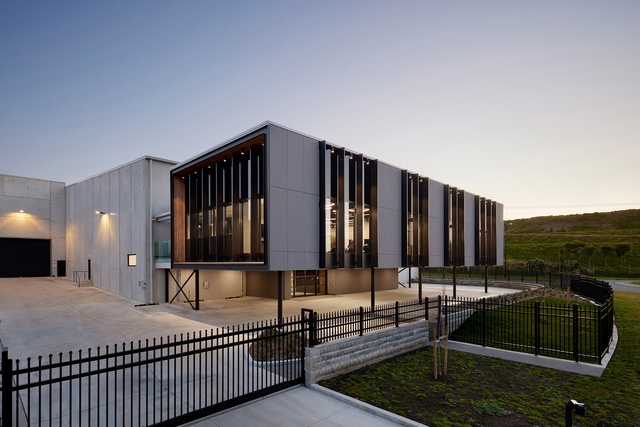
This commercial building — with office, warehouse and research and development laboratory – is an excellent example of how an industrial building can be functional as well as elegant and sophisticated. It’s a refined workplace with a high-quality aesthetic response, innovative joinery solutions complete with concealed doors, and flexible meeting areas. There is a considered eye for detail at every juncture. Natural light is used in abundance and there is easy access to outdoor spaces. Modern, warm interior materials and finishes have resulted in a building that is a joy to inhabit and an excellent showcase of the client’s own lighting products.
Education
The Pā by Architectus, Jasmax and Design Tribe
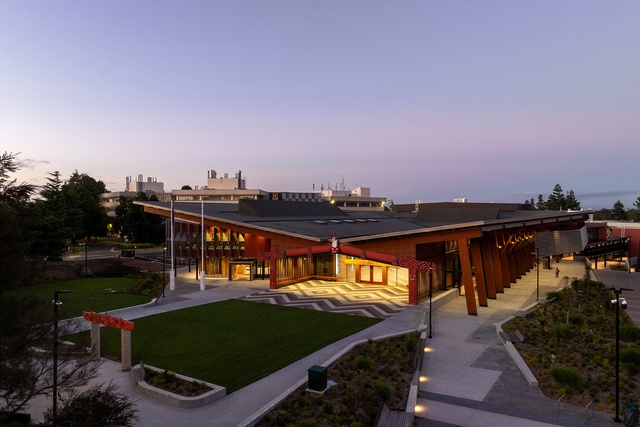
Somewhat dichotomously, The Pā successfully delivers both a new entry point and heart for the University of Waikato, stitching together the four key functions of wharenui, executive leadership, central student hub and Faculty of Māori and Indigenous Studies, with clear regard to context and surrounding linkages. Manaakitanga is expressed through the project’s organisation and design, including development and extension of traditional Māori construction into new manifestations and metaphors such as the crossing, rather than termination, of the heke (rafters) at the tāhuhu (ridge beam). This extends and supports the unifying roof that protects the various activities below, fostering gathering and community. The strong narrative, formed in close collaboration with the office of the Kīngitanga, reads throughout the design and respects the history of the whenua, Ngāti Hauā and Ngāti Wairere and their landmarks, anchoring the project into the Waikato.
Resene Colour Award
The colours, both applied and inherent to the materials, consistently support and express the design narrative, unify the facility’s four key functions and provide a warm and welcoming experience.
Te Kura o Manunui by ASC Architects
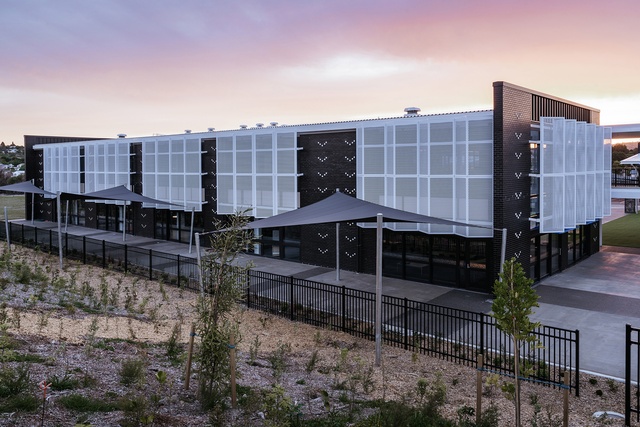
Te Kura o Manunui shines as an inspiring place of learning for tamariki, where kaupapa, tikanga, te reo Māori and community are entwined in the school’s vision. Collaboration with mana whenua, Ngāi Tamarāwaho, is evident in the cultural narrative that informs the planning, building graphics and landscaping. The refreshingly simple material selection includes monochrome black brick veneer accented with a white motif that reflects a bird in flight. Throughout the project, references to the site context through images of Mauao help to celebrate place.
Tauranga Boys’ College – New Teaching Block by Designgroup Stapleton Elliott
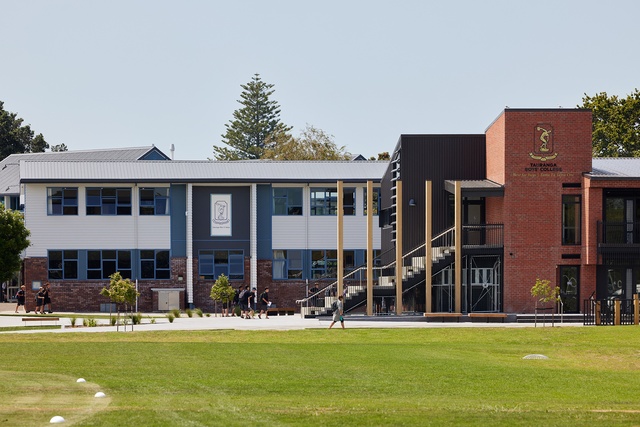
This project comprises a new teaching block, staff carpark extension and the development of external courtyard spaces. The project transforms a previously under-utilised area into an integral, multi-functional part of the campus. The two-storey building aligns with the vehicle entry as a continuation of the public edge and addresses the street boundary with a shrouded roof form. Classrooms can be independent or interconnected, providing flexible learning spaces that open into shared communal zones to provide a multitude of learning environments and educational opportunities. The result is a unique, specific and meaningful design that motivates learning in a variety of settings and has improved outcomes for all its users.
Enduring Award
Cranwell Place (1970) by Noel D’Arcy Blackburn
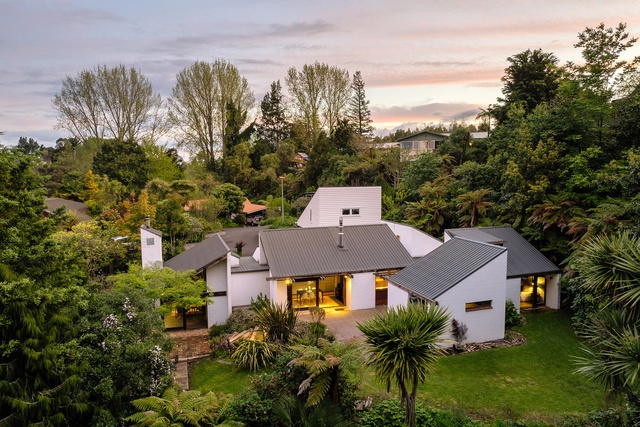
This is a well-crafted, warm and welcoming home designed by the architect for his wife and young family. The house sits within an L-shaped floorplan, with the centre facing a courtyard that looks north towards a gully. Internal spaces are compartmentalised and expressed through different levels, and externally through different roof forms. The house features a generous kitchen for its time, with wide, full-height sliding doors, and built-in cabinets, shelves and bookcases expressing a high level of detail and craft. An original gem well worth celebrating.
The NZIA Architecture Awards programme is supported by Resene and APL.


